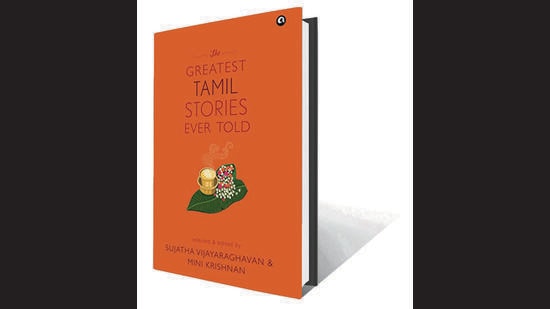Review: The Greatest Tamil Stories Ever Told, Selected and edited by Sujatha Vijayaraghavan and Mini Krishnan
A few years ago, bilingual writer, musician, and dance scholar Sujatha Vijayaraghavan embarked on an ambitious journey to read hundreds of classic Tamil stories. The ones that didn’t fit into her dance project back then, have found a home in this collection, an anthology of 30 Tamil short stories, writings from the 1930s till today that embody the gloom and despair, the grit and grace, and the spirit and skill of the Thamizh people.
Every story is unique, representing all strata of society, highlighting caste, class, and gender issues, and capturing in full colour and with remarkable ease the lives and times of the Tamils. Most are “modern” and by writers who are household names in Tamil Nadu. Many have been written with dollops of humour to convey the plight of bleeding hearts and scorched souls – as the “Thamizh people love a laugh,” writes Vijayaraghavan.
Vijayaraghavan and Mini Krishnan have co-authored the anthology with Malini Seshadri translating most of the stories. The collection opens with The Village Experience, a tragicomic story by SVV, that uncorks a world of emotions. An old couple undertake an arduous trip to a remote village to condole the death of the couple’s “daughter’s mother-in-law’s father”. The death was not untimely as the man was 80 but it was an “important death” by society’s standards. While the wife is worried about what people would say if they missed the condolence visit, the husband is angry: “Let’s take all children, servants, sweeper… everyone in our house. That way we can demonstrate even better to them that our whole house is in deep grief.”

Kalki Krishnamurthy’s The Governor’s Visit, one of the oldest stories in the book, is a tongue-in-cheek account of how local dignitaries in small towns appeased colonial rulers in pre-Independent India. When news of the English governor’s impending visit to lay the foundation stone of a bridge reached Chettiar and Iyengar, they competed with each to be obsequious and fawn over the Englishman.
In her introduction, Vasantha Surya points out that two features bind these nuanced stories: one, they are heirs to “the only language of contemporary India which is recognisably continuous with a classical past”, and, two, the part writers “play in nurturing a literary aesthetic premised on a no-holds-barred ethic of doubt and questioning”.
Within these pages, we encounter the strong Thamizh woman, who, as Vijayaraghavan points out, is capable of warding off “a charging tiger armed with nothing more than a winnow”. The story that hits the hardest in this context is that of Kamalan (Journey 4 by Ambai), who turns her sly, dowry-seeking bridegroom away, and takes charge of her life in an unconventional and extraordinary way. The compromises she makes, and the secrets she carries, are sure to rattle the social order.
In contrast, The First Night by Ki Ra is a cutesy story about a bride who is welcomed into her new home by a cat. Basu arches its back, rubs against the bride’s legs, and purrs with pleasure, as the husband and wife try to snatch private moments in a joint household.
Surya asserts that Tamil bears the imprint of other languages – not only Sanskrit, and the sister languages of the Dravidian family such as Telegu and Malayalam – but also Arabic and Persian, Urdu and Hindi, and English.
Space Travellers by Thoppil Mohamed Meeran and translated by Prabha Sridevan is a fine example of this. The tension N Raman manages to create and sustain in his translation of Perumal Murugan’s The Goat Thief deserves applause.
Although it is difficult to choose from such a grand range of stories, my personal favourites are Letters from the Inner Palace by Kumudini and God and Kandasami Pillai by Pudumaipittan.
Sita Devi of Ayodhya’s letters to her Amma cannot be read with a straight face. “You wrote that a sindhur-coloured, deep red sari is being woven for me. Here in Ayodhya, people are very fastidious about the way they dress… All the saris that you bought for my wedding have broad borders. I feel so embarrassed…” a harried Sita writes to her mother. The mother dutifully keeps changing the colour schemes and designs to meet her daughter’s demands, till this letter arrives: “No need to send any sari. All is over. We are going away to the forest…if possible, send a bark-skin.”
God visits Kandasami Pillai, the 45-year-old, who looks like he has been “deprived of food for 45 years”. God reveals his identity and wants to be Pillai’s guest, but the latter is unimpressed and agitated. “Please stay as long as you wish, I have no objection at all. Only, please don’t tell everyone that you are God. It doesn’t matter if others take you for a madman but my wife mustn’t take me for one.” Vijayaraghavan states that Pudumaipittan’s story is “one of the earliest examples of magic realism, written decades before the term was coined”.
Certificate by Anbaathavan highlights the caste and class divide – a young snake charmer trying to move heaven and earth to get a caste certificate, which he desperately needs to enrol in senior school. Irulaandi undertook several trips to the collector’s office, pleading with even the doorman to help him. When it dawns on the frustrated boy that the elusive certificate will never be his, he steps into the collector’s office and lets loose a bag full of snakes.

Another touching story in this anthology is My name is Madhavan by R Chudamani – about an exceptionally capable blind boy. With just a few simple details, the reader sees how society stigmatises and stereotypes the visually-impaired.
In a simplistic style that veils complex philosophy, La Sa Ra raises existentialist questions in Rivulets: “Why are we born? Only to meet and part, meet and part, endlessly, till one day we part permanently? Is parting the goal of existence?”
The Door Closes by CS Chellappa is an exceptionally moving story about Prisoner Number 623 and his last day in prison. This is the story of our times, as we are witnessing politically-motivated arrests. Prisoner Number 623 isn’t celebrating his impending freedom, which is only hours away, but is worried about the hundreds of doors being shut on him when the prison door “vomits him out” into the world.
The only plausible explanation for this remarkably diverse and striking anthology, which contains stories that vary in theme and tone, is that, to quote Surya, the Tamil language has a strong spine, and “has refused to yield to the asphyxiating embrace of purists”.
Lamat R Hasan is an independent journalist. She lives in New Delhi.
A few years ago, bilingual writer, musician, and dance scholar Sujatha Vijayaraghavan embarked on an ambitious journey to read hundreds of classic Tamil stories. The ones that didn’t fit into her dance project back then, have found a home in this collection, an anthology of 30 Tamil short stories, writings from the 1930s till today that embody the gloom and despair, the grit and grace, and the spirit and skill of the Thamizh people.

Every story is unique, representing all strata of society, highlighting caste, class, and gender issues, and capturing in full colour and with remarkable ease the lives and times of the Tamils. Most are “modern” and by writers who are household names in Tamil Nadu. Many have been written with dollops of humour to convey the plight of bleeding hearts and scorched souls – as the “Thamizh people love a laugh,” writes Vijayaraghavan.
Vijayaraghavan and Mini Krishnan have co-authored the anthology with Malini Seshadri translating most of the stories. The collection opens with The Village Experience, a tragicomic story by SVV, that uncorks a world of emotions. An old couple undertake an arduous trip to a remote village to condole the death of the couple’s “daughter’s mother-in-law’s father”. The death was not untimely as the man was 80 but it was an “important death” by society’s standards. While the wife is worried about what people would say if they missed the condolence visit, the husband is angry: “Let’s take all children, servants, sweeper… everyone in our house. That way we can demonstrate even better to them that our whole house is in deep grief.”

Kalki Krishnamurthy’s The Governor’s Visit, one of the oldest stories in the book, is a tongue-in-cheek account of how local dignitaries in small towns appeased colonial rulers in pre-Independent India. When news of the English governor’s impending visit to lay the foundation stone of a bridge reached Chettiar and Iyengar, they competed with each to be obsequious and fawn over the Englishman.
In her introduction, Vasantha Surya points out that two features bind these nuanced stories: one, they are heirs to “the only language of contemporary India which is recognisably continuous with a classical past”, and, two, the part writers “play in nurturing a literary aesthetic premised on a no-holds-barred ethic of doubt and questioning”.
Within these pages, we encounter the strong Thamizh woman, who, as Vijayaraghavan points out, is capable of warding off “a charging tiger armed with nothing more than a winnow”. The story that hits the hardest in this context is that of Kamalan (Journey 4 by Ambai), who turns her sly, dowry-seeking bridegroom away, and takes charge of her life in an unconventional and extraordinary way. The compromises she makes, and the secrets she carries, are sure to rattle the social order.
In contrast, The First Night by Ki Ra is a cutesy story about a bride who is welcomed into her new home by a cat. Basu arches its back, rubs against the bride’s legs, and purrs with pleasure, as the husband and wife try to snatch private moments in a joint household.
Surya asserts that Tamil bears the imprint of other languages – not only Sanskrit, and the sister languages of the Dravidian family such as Telegu and Malayalam – but also Arabic and Persian, Urdu and Hindi, and English.
Space Travellers by Thoppil Mohamed Meeran and translated by Prabha Sridevan is a fine example of this. The tension N Raman manages to create and sustain in his translation of Perumal Murugan’s The Goat Thief deserves applause.
Although it is difficult to choose from such a grand range of stories, my personal favourites are Letters from the Inner Palace by Kumudini and God and Kandasami Pillai by Pudumaipittan.
Sita Devi of Ayodhya’s letters to her Amma cannot be read with a straight face. “You wrote that a sindhur-coloured, deep red sari is being woven for me. Here in Ayodhya, people are very fastidious about the way they dress… All the saris that you bought for my wedding have broad borders. I feel so embarrassed…” a harried Sita writes to her mother. The mother dutifully keeps changing the colour schemes and designs to meet her daughter’s demands, till this letter arrives: “No need to send any sari. All is over. We are going away to the forest…if possible, send a bark-skin.”
God visits Kandasami Pillai, the 45-year-old, who looks like he has been “deprived of food for 45 years”. God reveals his identity and wants to be Pillai’s guest, but the latter is unimpressed and agitated. “Please stay as long as you wish, I have no objection at all. Only, please don’t tell everyone that you are God. It doesn’t matter if others take you for a madman but my wife mustn’t take me for one.” Vijayaraghavan states that Pudumaipittan’s story is “one of the earliest examples of magic realism, written decades before the term was coined”.
Certificate by Anbaathavan highlights the caste and class divide – a young snake charmer trying to move heaven and earth to get a caste certificate, which he desperately needs to enrol in senior school. Irulaandi undertook several trips to the collector’s office, pleading with even the doorman to help him. When it dawns on the frustrated boy that the elusive certificate will never be his, he steps into the collector’s office and lets loose a bag full of snakes.

Another touching story in this anthology is My name is Madhavan by R Chudamani – about an exceptionally capable blind boy. With just a few simple details, the reader sees how society stigmatises and stereotypes the visually-impaired.
In a simplistic style that veils complex philosophy, La Sa Ra raises existentialist questions in Rivulets: “Why are we born? Only to meet and part, meet and part, endlessly, till one day we part permanently? Is parting the goal of existence?”
The Door Closes by CS Chellappa is an exceptionally moving story about Prisoner Number 623 and his last day in prison. This is the story of our times, as we are witnessing politically-motivated arrests. Prisoner Number 623 isn’t celebrating his impending freedom, which is only hours away, but is worried about the hundreds of doors being shut on him when the prison door “vomits him out” into the world.
The only plausible explanation for this remarkably diverse and striking anthology, which contains stories that vary in theme and tone, is that, to quote Surya, the Tamil language has a strong spine, and “has refused to yield to the asphyxiating embrace of purists”.
Lamat R Hasan is an independent journalist. She lives in New Delhi.
